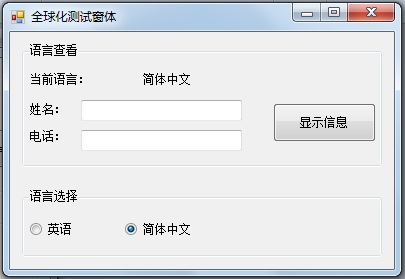C# WinForm国际化实现的简单方法
软件行业发展到今天,国际化问题一直都占据非常重要的位置,而且应该越来越被重视。对于开发人员而言,在编写程序之前,国际化问题是首先要考虑的一个问题,也许有时候这个问题已经在设计者的考虑范围之内,但终归要开发人员去做实现的。因此,如何实现国际化,是开发人员必须掌握的一项基本技能。
今天,这里要讲的就是,在利用C#进行WinForm开发时,国际化是怎么实现的。鉴于时间及篇幅关系,这里仅仅介绍一种简单的国际化实现方法,可能这里提到的方法已经有非常多人提到过,但笔者还是不厌其烦地介绍一下。
要在C#中实现国际化,需要相关资源文件,比如要在一个软件中支持英文、中文两种语言,那么就必须有这两种语言的资源文件,这在C#中可以采用资源文件(后缀名为.resx)来实现,我们不妨定义英文资源文件名称为Resource.en-US,中文资源文件名称为Resource.zh-CN,两种资源文件所涉及的ID都应该是一样的(这对于其他更多的资源文件均是一样的),只不过是展示的名称不同罢了。
有了这两种资源文件,接下来就要考虑如何做的问题了。为了适应多处使用的情形,这里笔者单独编写了一个类ResourceCulture,该类包含了一些静态方法,主要作用是用来设置当前语言及返回当前的语言的相关字符串。该类代码如下:
using System.Reflection;
using System.Resources;
using System.Threading;
using System.Globalization;
namespace GlobalizationTest
{
class ResourceCulture
{
/// <summary>
/// Set current culture by name
/// </summary>
/// <param name="name">name</param>
public static void SetCurrentCulture(string name)
{
if (string.IsNullOrEmpty(name))
{
name = "en-US";
}
Thread.CurrentThread.CurrentCulture = new CultureInfo(name);
}
/// <summary>
/// Get string by id
/// </summary>
/// <param name="id">id</param>
/// <returns>current language string</returns>
public static string GetString(string id)
{
string strCurLanguage = "";
try
{
ResourceManager rm = new ResourceManager("GlobalizationTest.Resource", Assembly.GetExecutingAssembly());
CultureInfo ci = Thread.CurrentThread.CurrentCulture;
strCurLanguage = rm.GetString(id, ci);
}
catch
{
strCurLanguage = "No id:" + id + ", please add.";
}
return strCurLanguage;
}
}
}
在Form1中的代码如下:
/**
* This project is just a example to show how to do the globalization in C# winform.
* You and rebuild and/or modify it by yourself if you want.
* Specially, this project was created in Visual Studio 2010.
*
* Project Name : GlobalizationTest
* Create Date : April 29th, 2010
* */
using System;
using System.Windows.Forms;
namespace GlobalizationTest
{
public partial class Form1 : Form
{
public Form1()
{
InitializeComponent();
}
/// <summary>
/// Set the resource culture
/// </summary>
private void SetResourceCulture()
{
// Set the form title text
this.Text = ResourceCulture.GetString("Form1_frmText");
// Set the groupbox text
this.gbLanguageView.Text = ResourceCulture.GetString("Form1_gbLanguageViewText");
this.gbLanguageSelection.Text = ResourceCulture.GetString("Form1_gbLanguageSelectionText");
// Set the label text
this.lblCurLanguageText.Text = ResourceCulture.GetString("Form1_lblCurLanguageText");
this.lblNameText.Text = ResourceCulture.GetString("Form1_lblNameText");
this.lblPhoneText.Text = ResourceCulture.GetString("Form1_lblPhoneText");
// Set the button text
this.btnMsgShow.Text = ResourceCulture.GetString("Form1_btnMsgShowText");
// Set radiobutton text
this.rbEnglish.Text = ResourceCulture.GetString("Language_EnglishText");
this.rbChinese.Text = ResourceCulture.GetString("Language_ChineseText");
// Set the current language text
if (rbEnglish.Checked)
{
this.lblCurLanguage.Text = ResourceCulture.GetString("Language_EnglishText");
}
else if (rbChinese.Checked)
{
this.lblCurLanguage.Text = ResourceCulture.GetString("Language_ChineseText");
}
}
private void Form1_Load(object sender, EventArgs e)
{
// Set the default language
ResourceCulture.SetCurrentCulture("en-US");
this.SetResourceCulture();
}
private void btnMsgShow_Click(object sender, EventArgs e)
{
if(string.IsNullOrEmpty(txtName.Text))
{
MessageBox.Show(ResourceCulture.GetString("Form1_msgbox_nameText"), ResourceCulture.GetString("Form1_msgbox_TitleText"),
MessageBoxButtons.OK, MessageBoxIcon.Exclamation);
return;
}
if (string.IsNullOrEmpty(txtPhone.Text))
{
MessageBox.Show(ResourceCulture.GetString("Form1_msgbox_phoneText"), ResourceCulture.GetString("Form1_msgbox_TitleText"),
MessageBoxButtons.OK, MessageBoxIcon.Exclamation);
return;
}
MessageBox.Show(ResourceCulture.GetString("Form1_msgbox_InfoText") + txtName.Text + ", " + txtPhone.Text,
ResourceCulture.GetString("Form1_msgbox_TitleText"), MessageBoxButtons.OK, MessageBoxIcon.Information);
}
private void rbEnglish_CheckedChanged(object sender, EventArgs e)
{
ResourceCulture.SetCurrentCulture("en-US");
this.SetResourceCulture();
}
private void rbChinese_CheckedChanged(object sender, EventArgs e)
{
ResourceCulture.SetCurrentCulture("zh-CN");
this.SetResourceCulture();
}
}
}
最终的效果如下图1和图2所示:

图1

归结起来,要在C#的WinForm中实现国际化,至少需要做好以下几点:
(1)准备所需资源文件(如本文中提到的英文和中文资源文件);
(2)引入命名空间(包括:System.Reflection、System.Resources、System.Threading和System.Globalization);
(3)实例化资源管理器(即ResourceManager);
(4)设置当前进程的语言区域;
(5)通过资源管理器从指定的资源文件中获取所需值。
通过上述的方法即可简单实现国际化。
相关文章
- 本篇文章是对C#中WinForm控件之Dock顺序调整进行了详细的分析介绍,需要的朋友参考下...2020-06-25
- 这篇文章主要介绍了C# Winform中实现主窗口打开登录窗口关闭的方法,这在需要用户名密码的软件项目中是必用的一个技巧,要的朋友可以参考下...2020-06-25
- 下面小编就为大家带来一篇C# winform打开Excel文档的方法总结(必看篇)。小编觉得挺不错的,现在就分享给大家,也给大家做个参考。一起跟随小编过来看看吧...2020-06-25
- 这篇文章主要给大家介绍C# winform快捷键设置技巧,涉及到C winform快捷键相关知识,对C winform知识感兴趣的朋友可以参考下本篇文章...2020-06-25
c#中Winform实现多线程异步更新UI(进度及状态信息)
本篇文章主要介绍了c#中Winform实现多线程异步更新UI(进度及状态信息) ,小编觉得挺不错的,现在分享给大家,也给大家做个参考。一起跟随小编过来看看吧...2020-06-25- 这篇文章主要给大家介绍了关于c# winform异步不卡界面的实现方法,文中通过示例代码介绍的非常详细,对大家学习或者使用c#具有一定的参考学习价值,需要的朋友们下面来一起学习学习吧...2020-06-25
C# WinForm程序处理后台繁忙导致前台控件假死现象解决方法
这篇文章主要介绍了C# WinForm程序处理后台繁忙导致前台控件假死现象解决方法,本文通过Application.DoEvents()解决这个问题,并讲解了Application.DoEvents()的作用,需要的朋友可以参考下...2020-06-25- 这篇文章主要介绍了C#中winform使用相对路径读取文件的方法,实例分析了C#使用相对路径读取文件的技巧与实际应用,需要的朋友可以参考下...2020-06-25
- 这篇文章主要介绍了C#在Winform开发中使用Grid++报表,文中通过示例代码介绍的非常详细,对大家的学习或者工作具有一定的参考学习价值,需要的朋友们下面随着小编来一起学习学习吧...2020-06-25
winform中的ListBox和ComboBox绑定数据用法实例
这篇文章主要介绍了winform中的ListBox和ComboBox绑定数据用法,实例分析了将集合数据绑定到ListBox和ComboBox控件的技巧,具有一定参考借鉴价值,需要的朋友可以参考下...2020-06-25- 这篇文章主要为大家详细介绍了C# WinForm程序设计简单计算器,具有一定的参考价值,感兴趣的小伙伴们可以参考一下...2020-06-25
C# WinForm控件对透明图片重叠时出现图片不透明的简单解决方法
这篇文章主要介绍了C# WinForm控件对透明图片重叠时出现图片不透明的简单解决方法,结合实例形式分析了WinForm图片重叠后造成图片不透明的原因与相应的解决方法,需要的朋友可以参考下...2020-06-25- 在工作中遇到这样一个问题,在系统使用过程中,输入法会变灰导致无法使用输入法输入文字,就好像输入法被禁用了没有启用似的。对此,在这里做个备录...2020-06-25
- 这篇文章主要介绍了C#实现Winform中打开网页页面的方法,涉及WinForm中WebBrowser的相关使用技巧,具有一定参考借鉴价值,需要的朋友可以参考下...2020-06-25
C#实现winform中RichTextBox在指定光标位置插入图片的方法
这篇文章主要介绍了C#实现winform中RichTextBox在指定光标位置插入图片的方法,涉及RichTextBox控件及剪切板的相关操作技巧,非常简单实用,需要的朋友可以参考下...2020-06-25C# Winform 调用系统接口操作 INI 配置文件的代码
封装了一小段代码, 调用系统接口, 操作配置文件. 一般用于 .ini 文件, 或者其它键值对格式的配置文件...2020-06-25- 这篇文章主要介绍了WinForm调用百度地图接口用法,结合具体实例形式简单分析了WinForm WebBrower控件与前端百度接口交互的相关操作技巧,需要的朋友可以参考下...2020-06-25
- 在.NET应用中,导出Excel是很常见的需求,导出Excel报表大致有以下三种方式:Office PIA,文件流和NPOI开源库,本文只介绍前两种方式...2020-06-25
- 这篇文章主要介绍了C# WinForm中禁止改变窗口大小的方法,需要把FormBorderStyle和MaximizeBox的值固定即可,需要的朋友可以参考下...2020-06-25
- 这篇文章主要介绍了C# inForm编程获取文件物理路径的方法,获取的物理路径是软件即软件安装所在目录,需要的朋友可以参考下...2020-06-25
